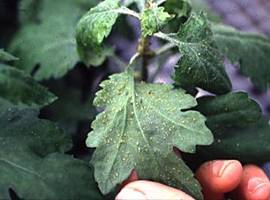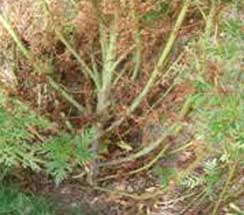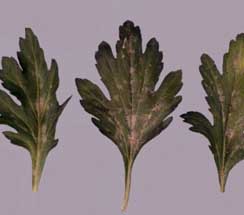1)Birbal Sahni:
- The variety gets mature in 121 days.
- The plant is 65cm tall.
- The plant has white color flowers which grow in bunch and having 4-8cm diameter.
- It gives an average yield of 13qtl/acre.
2)Baggi:
- The variety gets mature in 137 days.
- The plant is 64cm tall.
- The plant has white color flowers which grow in bunches and having 4-8cm diameter.
- It gives an average yield of 60qtl/acre.
3) Ratlaam Selection:
- The variety gets ready in 138 days.
- The plant is 51cm tall.
- The plant has yellowish white color flowers which are 8.1cm in diameter.
- It gives an average yield of 72qtl/acre.
4)Punjab Gold:
- Early maturing variety.
- The variety gets ready in 76 days.
- The plant is 23cm tall.
- The plant has red color flower buds which becomes attractive yellow in color when matures.
- The flowers are 5-30cm in diameter.
- The variety is suitable for growing in pots.
5) Anmol:
- Late maturing variety.
- The variety gets ready in 114 days.
- The plant is 50cm tall.
- The plant has yellow color flowers which grow in bunches and having 40cm diameter.
- It gives an average yield of 13qtl/acre.
- Single plant of this variety gives bears approximately 208 flowers.
6)Royal Purple: - Late maturing variety.
- The variety gets ready in 141 days.
- The plant is 45cm tall.
- The plant has purple-pink color flowers which grow in bunches and having 5.3cm diameter.
- Single plant of this variety gives bears approximately 201 flowers.
- This variety is also suitable for pot planting.
7)Yellow delight: - Early maturing variety.
- The variety gets ready in 88 days.
- The plant is 66cm tall having attractive yellow color flowers.
- The flowers are 5.2cm in diameter.
- Single plant of this variety gives bears approximately 103 flowers.
8) Garden Beauty:
- Medium maturing variety which gets mature in 132 days.
- The plant is 70 cm tall and flowers have 10 cm diameter which is uniform in color.
- It gives 73 flowers/plant.
- The flowering starts within 23 days of sowing.
9)Winter Queen:
- Medium maturing variety which gets mature in 128 days.
- The plant is 75 cm tall and flowers have 90 cm diameter which is uniform in color.
- It gives 125 flowers/plant.
- The flowering starts within 23 days of sowing.
10)Atom Joy: - Early maturing variety which gets mature in 101 days.
- The plant is 58cm tall.
- The variety contains pink color flowers which are 6.6cm in diameter.
- It gives 283flowers/plant.
- The flowering starts within 36 days of sowing.
11)Kelvin Mandrin: - Dwarf flower variety which gives approximately 102 flowers.
- It has copper color flowers which are 4.5cm in diameter.
- The plant is 48cm tall.
- The variety starts flowering after 40 days.
12) Kelvin tattoo:
- Dwarf flower variety which gives approximately 101 flowers.
- It has cadmium yellow color flowers which are red color from medium having diameter of 3.37cm.
- The plant is 41cm tall.
- The variety starts flowering after 31 days.
13)Reagan White:
- The variety starts flowering after 103 days.
- The plant is 45cm tall.
- It has white color flowers having diameter of 8.43cm.
- It gives 54flowers/plant.
14) Reagan Emperor: - Single Korean variety which mature in 103 days.
- The plant is 78 cm tall and pink color flowers which has 8.15 cm diameter.
- It gives 25 flowers/plant.
- It matures in 30 days.
15)Yellow Charm:
- Belongs to Cinerarias category.
- The variety has 15cm plant height.
- It gives 485 flowers/ plant.
- It has shining yellow color flowers having 3.5cm in diameter.
- This variety doesn’t require training and pruning and doesn’t require support.
- It matures in 36 days.
16)Ajay: - Medium flower size variety which gets ready in 116 days.
- The plant has 55cm height and 79flowers per plant.
- It has shining yellow color flowers having 8.18cm diameter.
- The variety starts flowering after 37 days.
17) Mother Teresa:
- Medium size variety of Enimon category which starts flowering in 102 days.
- It has 38 cm plant height which gives 150 flowers per plant.
- It has white color flowers which are cream or yellow in color from middle.
- The flowers have diameter of 5.5cm.
- It is a late maturing variety which starts blooming in December-January month.
- This variety doesn’t require training and pruning and doesn’t require support.
Other varieties: Kirti, Arka Swarna, Shanti, Y2K, Arka Ganga, Appu, Sadbhavana, Bindiya, MDU 1 (yellow colored flowers), Combaitore varieties such as CO 1 (yellow colored varieties) and CO 2 (purple colored flowers), Indira and Red Gold, Ravi Kiran, Akash, Yellow Start, Indira, Rakhee and Chandrakand are some more varieties which are used.







